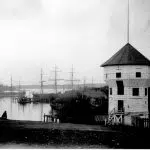
Huge Puerto Rico radio telescope to close in blow to science
SAN JUAN, Puerto Rico — The National Science Foundation announced Thursday that it will close the huge telescope at the renowned Arecibo Observatory in Puerto Rico in a blow to scientists worldwide who depend on it to search for planets, asteroids and extraterrestrial life.
The independent, federally funded agency said it’s too dangerous to keep operating the single dish radio telescope — one of the world’s largest — given the significant damage it recently sustained. An auxiliary cable broke in August and tore a 100-foot hole in the reflector dish and damaged the dome above it. Then on Nov. 6, one of the telescope’s main steel cables snapped, causing further damage and leading officials to warn that the entire structure could collapse.
NSF officials noted that even if crews were to repair all the damage, engineers found that the structure would still be unstable in the long term.
“This decision is not an easy one for NSF to make, but the safety of people is our number one priority,” said Sean Jones, the agency’s assistant director for the Mathematical and Physical Sciences Directorate. “We understand how much Arecibo means to this community and to Puerto Rico.”


